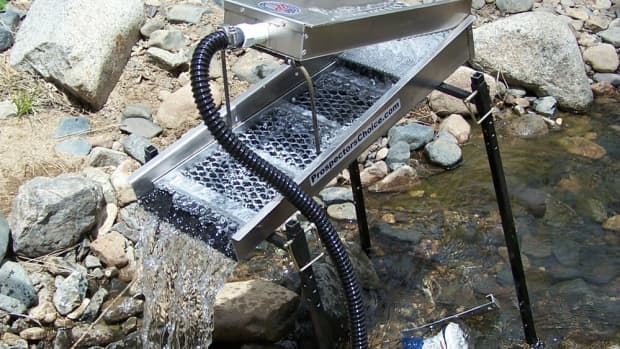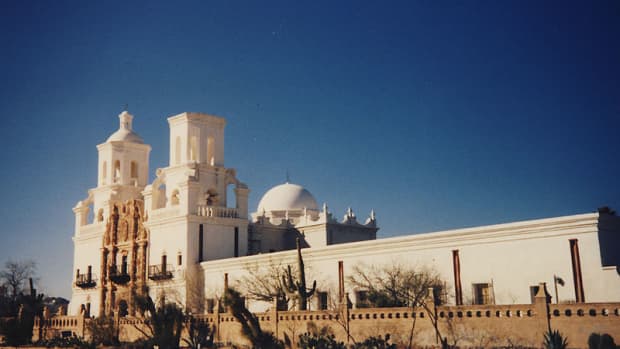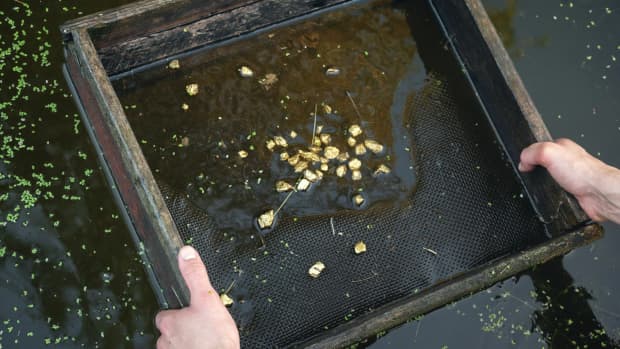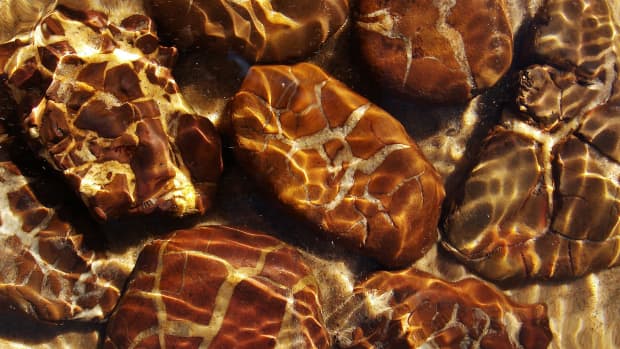Ancient Mining Tools and Techniques
Gold, Silver, Copper: Charming Jewelry
Evidence has it that gold has been mined since about 3000 BC. The oldest objects of gold were discovered in the Sumerian capital of Ur, which is in the southeastern part of present-day Iraq.
There, a royal tomb was excavated, revealing gold chains for jewelry. From 2500 BCE on, gold was produced for jewelry and found in Egyptian tombs. Objects have been discovered, including necklaces, bracelets, earrings, rings, diadems, pendants, pins, and brooches. The ancients mined it for their rulers for ages.
It Appears to Be Solid Gold
Electrum is a naturally occurring alloy of gold and silver, with trace amounts of copper and other metals. It has also been produced artificially, and is often known as green gold. The ancient Greeks called it 'gold' or 'white gold', as opposed to 'refined gold'. Its color ranges from pale to bright yellow, depending on the proportions of gold and silver.
Gold Makes Good Money
Because it is rare, has a dazzling luminescence, and is very malleable, it has been sought after since time immemorial by rulers as a display of power. As the concept of a currency took hold in bygone civilizations, gold was easily pounded into coin shapes. Molds were built in which the gold was hammered. Though soft, it held its shape. It was neither brittle nor prone to tarnish (it does not oxidize) - all good characteristics for coinage.
Ulysses and the Golden Fleece
Arranging a sheep hide downstream of a water flow, ancient miners would trap even the smallest of flakes of gold in the fleece. When the fleece's absorption of gold flake had maxed out, the pelt was hung up to dry. Then, with some sort of covering spread beneath the hide it was gently tapped, allowing the gold to fall off and being recovered.
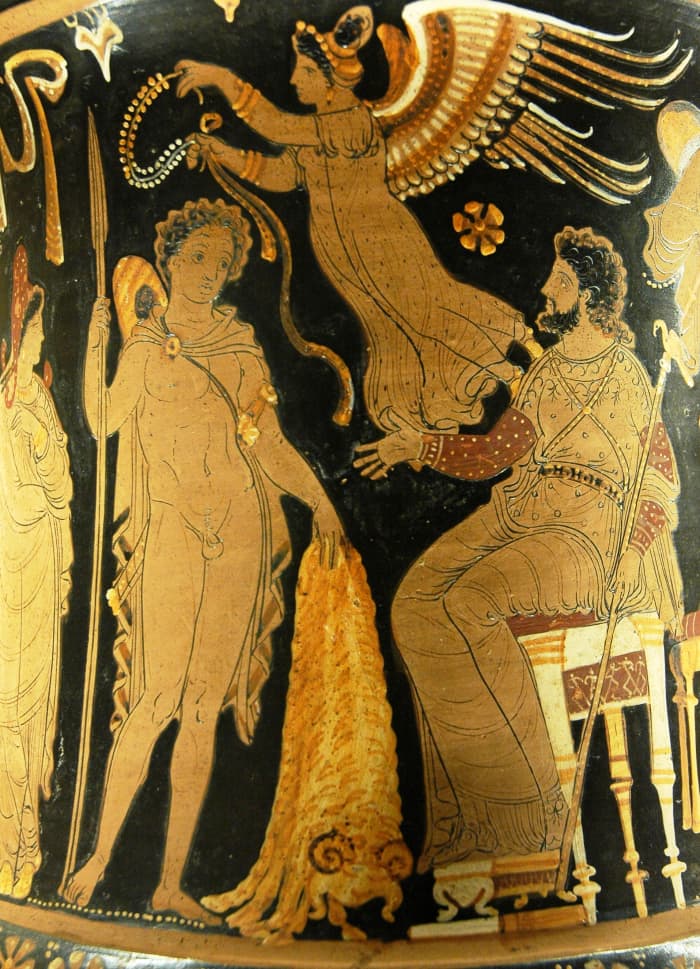
Jason brings Pelias the Golden Fleece; a winged victory prepares to crown him with a wreath. These images found on an ancient Roman vase
Rock Can Break Rock
Through the Stone Age and beyond, man required material to make and improve his tools and weapons. Many of the tools were made from rock and were used to break brittle ore. As late as the first century AD, Roman reporters claimed that flint was the hardest of materials. Small flint picks and hammers have been discovered around the world. The Egyptians mined flint as long ago as 50,000 years.
Pounding With Harder Rock
Hammering rock with stone implements does not seem very realistic, even for an ancient progressive culture. The ancients developed a system of fire-setting. They might dig away an area and then set a roaring fire which heated up the rock. After reaching an appropriate temperature, the fires would be doused with water to cause rapid cooling. This caused the rock ledges to become brittle, thus becoming easier to crack with stone tools.The ancient civilizations, including the Greeks and Romans used this technique.
Rock Riffles Carved by Man
East of Downieville, California it is reported that sluices were cut into solid rock. At about 5' wide, 6' deep, and with a trap every 20', 49ers washed out dirt above and ran it down through this carved sluice. It is not hard to imagine ancients doing the same thing. I have seen areas in Arizona where there are natural formations that act like a man-made sluice. If I see such areas warn into the rock, it is the first place I look for gold. These areas tend to slow the speed of the water and trap sediment. Frequently clays are trapped there and within it will lie gold flake.
Seeping Water Floods the Shafts
Of course, the ancients had the same types of problems when mining as modern day miners have experienced. Whenever you dig down, you risk hitting the water table. Dealing with water leaking into a shaft is tricky. The Archimedes's Screw is a machine historically used for transferring water from a low-lying body of water into irrigation ditches. Water is pumped by turning a screw-shaped tool inside a pipe. The Screw is limited by how much it can be leaned; at too high an angle the water runs backward.
Ancient Water Wheels
The favorite tool for removing water was the tympanum. Two wheels oriented next to each other would turn carrying water to higher level. When the water dumped out, it would run to another pair of wheels which would pick up the water. By repeating this up a shaft, water could be removed. These wheels were turned by slaves - animals could not be transferred down the vertical shafts. Food was also a critical consideration. Food was expensive and humans ate less. Such were the hard facts about ancient mining.
A Vast Roman Mining Region in Iberia
Riotinto is part of the Iberian Pyrite Belt stretching from Spain into Portugal. Archaeologists have learned a great deal from a Roman Riotinto mine located in Portugal. Eight pairs of wheels have been discovered there dating to 206 BC. They lifted water 30 meters and slaves had to work around the clock to keep the wheels turning in order to purge the water.
Recommended
Plenty of evidence shows how material was removed from old mines. Baskets woven with local grasses were often tethered together by rope and then drawn across the ground, or brought to the top of the mine by wooden pulleys.
Small ceramic cup-like lamps have been discovered in Phoenicia. Phoenicia is an ancient civilization that stretched through modern-day Syria, Lebanon and northern Israel. These bowl-shaped objects held burning oil to provide light for miners in these dark depths. The photograph of a Roman lamp is similar in shape - the miners' lamps had no engravings.
The lost-wax method of casting was developed in Egypt for holding molten copper. Wax is molded into the form of an object. This is then covered with clay. The wax is melted resulting in an earthen mold. Molten copper was then poured into the mold; most Egyptian copper molds were used for jewelry. This technique was used even prior to the Bronze Age, 4000 BC.
Harvesting A Metal Crop
Iron smelting from bog iron was invented during the Pre Roman Iron Age, and most Viking era iron was smelted from bog iron. In Northern and Northeastern Europe, bogs were the site of bog iron, the earliest form of iron used for tools. Iron compounds from plant decay precipitate out and are deposited at the bog bottom. These nuggets of iron were harvested and smelted to produce mining tools of wrought iron. Some people harvest iron in this manner to this day. New bog iron was formed each generation, so a son could harvest the bog when he became his father's age - a material source through regeneration
Gold, Copper, and Civilization
Gold and copper are found in their purest forms. It is speculated that the fire-setting method may have melted these or other metals which were observed to be strong or beautiful. These observations led ancient man to smelting for the production of weapons. This in turn led to wider uses and eventually the start of civilizations.Though mining causes degrees of contamination, without it, the progress man has made would not have been possible.

Archimedes screw as a piece of sculpture in the Netherlands demonstrating its function - photo by Polleket
Modern Prospecting Tools and Tests
- Ways to Test Gold Ore In the Field
You want to search for gold ore, but how do you identify good gold prospects? Simply crushing any rock, you could crush the rest of your life without finding a flake. Here are some simple field tests.
Sources
https://www.ancient.eu/gold/ by Mark Cartwright,
published on 04 April 2014
http://www.onlygold.com/Info/History-Of-Gold.asp, A Brief History of Gold, Who Discovered Gold?, Facts and Statistics
https://uwlabyrinth.uwaterloo.ca/labyrinth_archives/ancient_mining_techniques.pdf, Ancient Mining Techniques, by Chris Mundigler
https://en.wikipedia.org/wiki/Bog_iron, 24 April, 2018, Wikipedia
https://en.wikipedia.org/wiki/Reverse_overshot_water-wheel
http://barryyeoman.com/2010/09/the-mines-that-built-empires/, September 28, 2010, Barry Yeoman, For 5,000 years, Spain’s mineral riches created cash economies and global pollution
https://www.quora.com/Ancient-Civilizations-How-could-people-in-the-past-mine-for-metals, August 25, 2015, Renatus Peregrinus and Anthony Tauro, from Quora Ancient Civilizations: How could people in the past mine for metals?
https://www.tapatalk.com/groups/ancientlosttreasures/ancient-sluices-t3040.html, March 15, 2004, Ancient Lost Treasures
http://www.ancient-wisdom.com/mining.htm, Prehistoric Mining, Ancient-Wisdom, Alex Whitaker, 2012
https://www.miningreece.com/mining-greece/mining-history/ancient-mines/, Mininggreece.com, staff
This content is accurate and true to the best of the author’s knowledge and is not meant to substitute for formal and individualized advice from a qualified professional.
Questions & Answers
Question: What kinds of tools were used during ancient mining expeditions?
Answer: Fleece, crushing rock, rock sluices, Archimedean screw, tympanum, baskets, pulleys, lamps, and more.
Question: Was the arrastra used by the Phoenicians?
Answer: I found this out about Phoenicia and the arrastra on Wikipedia. Arrastras were widely used throughout the Mediterranean region since Phoenician times. The Spanish introduced the arrastra to the New World in the 16th century. The word "arrastra" comes from the Spanish language arrastrar, meaning to drag along the ground. Arrastras were suitable for use in small or remote mines, since they could be built from local materials and required little investment capital. For a really interesting article about Phoenician mining, please also see https://phoenicia.org/minning.html .
© 2018 John R Wilsdon
Comments
John R Wilsdon (author) from Superior, Arizona USA on April 06, 2020:
For some reason the first thing I take interest in when seeing an ancient endeavor is how in the world they did it. Sometimes the accomplishments of the ancients seem remarkable. Thanks for the comment.
Aurelio Locsin from Orange County, CA on April 05, 2020:
It never even occurred to me how they were mining these metals. Thanks for opening my eyes.









